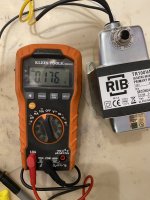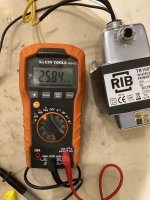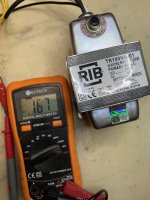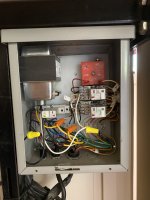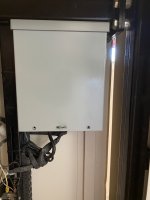Well, not exactly. If I can't find a fix for this, that will be a last option. To do it correctly and so it won't look like the inside of a warehouse, it's going to be expensive.But, reading through the posts... I see you did decide to put a three way AC switch.
I need to get a second lift for our backyard and will proably look at doing a 3 way switch in anticipation of a similar problem.
Yes! Easy to test, so probably worth doingAre you thinking the DC measurement I got already is incorrect?
Thanks,
Eric
No.With some current steering diodes? Or let some reverse current 'charge' up the battery?
No power switch should be required to make this reliable if properly designed. We all have all sorts of devices around the house that are continuously powered in some cases for decades without drawing any attention to themselves.
Something seems to be missing from the equation here, and I would guess there might be a rather significant amount of DC and lots of harmonic distortion on the mains. Impedance protected transformers aren't that great, but usually do not exhibit the performance problems seen here.
Something seems to be missing from the equation here, and I would guess there might be a rather significant amount of DC and lots of harmonic distortion on the mains. Impedance protected transformers aren't that great, but usually do not exhibit the performance problems seen here.
@Eric M You can discount the reading at 10A setting since there are likely to be serious measurement errors since the current is orders of magnitude lower than ideal for that meter range.
I would guess of the 3 based on experience around 26mA should be in the ball park. Do you have some high value power resistors to use to check current measurement accuracy with these meters?
I still recommend trying with a conventional transformer, the 50VA Antek I recommended is very inexpensive and would answer some questions.
I would guess of the 3 based on experience around 26mA should be in the ball park. Do you have some high value power resistors to use to check current measurement accuracy with these meters?
I still recommend trying with a conventional transformer, the 50VA Antek I recommended is very inexpensive and would answer some questions.
I put the 96 VA trans. in. I think I've tested the 250 VA long enough to know it will work, hopefully the 96 VA will also and I can just leave it in the control box and be done with it.
I'll run it for a few weeks. If no issue, I'll put the cover on the junction box and run a few more weeks. If I have an issue with overheating after installing the cover, I'll remove and see if that is enough to keep the transformer cool and not tripping.
At some point I'll need to put the housing cover back on. I guess that will be the real test.
I'm not going to do any more testing of the house mains. I can't change it so will need to find a work around if that is truly the issue. Keep in mind, everything else in the house works with no issues. I suspect if there was a real issue with "Dirty" AC power, myself and everyone in the neighborhood would be having issues with much more than handicap lifts.
Pics are with new transformer installed and cover on junction box. (I took the cover off after the picture)
I'll report back,
Thanks everyone.
I'll run it for a few weeks. If no issue, I'll put the cover on the junction box and run a few more weeks. If I have an issue with overheating after installing the cover, I'll remove and see if that is enough to keep the transformer cool and not tripping.
At some point I'll need to put the housing cover back on. I guess that will be the real test.
I'm not going to do any more testing of the house mains. I can't change it so will need to find a work around if that is truly the issue. Keep in mind, everything else in the house works with no issues. I suspect if there was a real issue with "Dirty" AC power, myself and everyone in the neighborhood would be having issues with much more than handicap lifts.
Pics are with new transformer installed and cover on junction box. (I took the cover off after the picture)
I'll report back,
Thanks everyone.
Attachments
That's what I would have thought. But, after hearing from the lift sales person who came by, that this was a known problem, and seeing the newly designed circuitry that replaced this, I'm wondering if the design or speced transformer isn't the issue after all.No power switch should be required to make this reliable if properly designed.
It wouldn't be the first time a large manufacturer made a mistake .... I have my 3rd recall notice from Toyota sitting on my desk right in front of me!
We are in SoCal and SoCal Edison is our utility....
I'm not going to do any more testing of the house mains. I can't change it so will need to find a work around if that is truly the issue. Keep in mind, everything else in the house works with no issues. I suspect if there was a real issue with "Dirty" AC power, myself and everyone in the neighborhood would be having issues with much more than handicap lifts.
...
For years, I had an issue with my power. I had a string of 4w Christmas incandescent lights on my patio and at night they would "flash" on their own and they kept burning out. I had no other issue anywhere in the house that I could detect. Since all of our wiring is rather new, back to the rebuild of '00, I doubted the problem was ours. I also had no motors running in the house when this happened... so I figured out the problem had to be upstream... but most of my neighbors had reported no issues..
I called Edison and they came in and "measured" but found no issues with their service. Their way of "measuring" is to put a dummy load and run half and full draw and measure the voltage, they don't measure noise.
Then one Christmas, talking to my neighbors, they found out they had the same thing on their Christmas lights. I called Edison and got nowhere. So, I put large UPS in my stereos, TVs and computers... just in case.
Three months later I went on a business trip... and when I got back I noticed the patio lights were not flashing. I spoke with my neighbors and they had noted Edison doing some work with a crane in the electrical vault near by ( our utilities are all underground ). So, I called Edison and they told me they had done some "maintenance" work... digging into it I found out they had replaced their transformer.
OK.. fast forward three years. I bought a large Sous Vide water bath oven... the way it works is by measuring the water temp and running the heating coil constantly until it reaches the desired temp. At that point, every minute it checks and if needed it pulses the heating coil on a 2Hz, 50% duty cycle until the temp is achieved again. The coils are 1400w so they draw some current from the 120. By now, one of my UPSs was a smart one that could detect voltage fluctuations...
.. so now I found out that I had bursts of low light pulses every so often at the patio lights.. the lights would dim for 30 seconds or so at a time... on a 2Hz, 50% duty cycle (1 sec normal, 1 sec dim, 1 sec normal, 1 sec dim...). I also saw this on the halogen lights connected to a dimmer set low...
I chased this down to the sous vide. The manufacturer exchanged it. It made no change...
Sure enough, after spending like 1000 bucks with an electrician checking the entire house we realized that when the sous vide was running it was drawing enough power that the voltage coming to the house was dropping to something like 108V ( or maybe 110).... We ran our own tests and yep, the voltage dropped with the current on rush. So, I called Edison again.. they came in, verified the line ( I got 300A service) and ran their draw test and told me that 108V was good for them. They would not change anything.... I asked them to run the test at a very low draw to see if we had a current issue somewhere.... nope, their tests do not allow for that.
As you can figure out the story.. a few months later, Edison came back and replaced their vault transformer yet again and ever since we've had no issues with our AC power.
IMHO, La Compañia Nacional de Electricidad de Guatemala has better quality power than SoCal Edison.
Also, don't assume your neighbors know much about such things. Mine are fine people but have no clue about deductive logic when even something like algebra ( count to ten ) or engineering is involved. We -who know why there are three prongs on a US AC plug- are in the very small minority.
Now, let's talk about natural gas and how the flame in our stove turns red after it rains......
Last edited:
We could devote an entire thread (Maybe even a forum) to PG&E up here in N CA. Briefly, I upgraded from 125 to 200 amps, I have paid PG&E the fee over a year ago. They still have 125 A service wires coming to my weatherhead. Neighbor to one side has the same story, paid for new overhead, he went from 100 to 200. Neighbor on the other side went from 125 to 320 ..... still has the skinny little alum. wire for a 125 service.
When you read about fires in N CA and how wind and trees are to blame, remember this story and don't think it doesn't happen everywhere. PG&E collects millions from customers to run new wires to their upgraded service and never do it. Those fires are caused by overloaded lines melting or transformers overheating and burning down entire communities. It's a little hard to prove since there is nothing left but ashes.
Sad story. And CA wants to eliminate gas ranges in favor of electric and go all electric vehicles by 2035! The state will burn to the ground before that happens. Look out Texas, more CA folks coming to turn your state Blue!!!
When you read about fires in N CA and how wind and trees are to blame, remember this story and don't think it doesn't happen everywhere. PG&E collects millions from customers to run new wires to their upgraded service and never do it. Those fires are caused by overloaded lines melting or transformers overheating and burning down entire communities. It's a little hard to prove since there is nothing left but ashes.
Sad story. And CA wants to eliminate gas ranges in favor of electric and go all electric vehicles by 2035! The state will burn to the ground before that happens. Look out Texas, more CA folks coming to turn your state Blue!!!
It is considered warm and perfectly Okay!!!Results of the 96 VA TR100VA001 Functional Devices transformer with the primary powered and no load on the secondary: 106 degrees F or 40 degrees C.
I think about 0.17A is quite reasonable, 25mA seems quite low for this transformer. What is the reading if you set the Neoteck meter to mA range?96 VA trans, primary current draw, secondary open.
2 meters, 3 different settings, you tell me which is correct.
Good job, that control cabinet looked a lot larger until you mounted the 96VA in! 🙂
Let's hope they used decent double insulated high temp magnet wire in the '96', the operating temp specs are pointing toward it so yes, fingers crossed.
WRT CRO mentioned earlier, highly recommended and they are not expensive these days. IMV, if you are doing any sort of DIYA a CRO is required.
WRT current meter, I have one of those compact ones permanently plugged into the 2kVA Variac OP. It's not accurate for low current readings but will easily show a fault winding up a few volts OP.
Good luck!
Let's hope they used decent double insulated high temp magnet wire in the '96', the operating temp specs are pointing toward it so yes, fingers crossed.
WRT CRO mentioned earlier, highly recommended and they are not expensive these days. IMV, if you are doing any sort of DIYA a CRO is required.
WRT current meter, I have one of those compact ones permanently plugged into the 2kVA Variac OP. It's not accurate for low current readings but will easily show a fault winding up a few volts OP.
Good luck!
Thanks.
Can you recommend a scope? I do audio work as well, it might be time for one.
I'm really thinking the cover on the junction box is a bad idea. I may try it but the entire box did get pretty warm before, that may be why it was missing. The cove for the lift protects from the electronics.
Well see.
Eric M.
Can you recommend a scope? I do audio work as well, it might be time for one.
I'm really thinking the cover on the junction box is a bad idea. I may try it but the entire box did get pretty warm before, that may be why it was missing. The cove for the lift protects from the electronics.
Well see.
Eric M.
Entry level scopes have gotten pretty darn good, and the cost very reasonable: https://www.amazon.com/Rigol-DS1202Z-Channel-Digital-Oscilloscope/dp/B07XSH2NR2/ref=sr_1_1?crid=28JGASDGN612D&keywords=oscilloscope,+200Mhz&qid=1686015780&sprefix=oscilloscope,+200mhz,aps,167&sr=8-1&ufe=app_do:amzn1.fos.ac2169a1-b668-44b9-8bd0-5ec63b24bcb5
You could spend as much or more for a good DVM: https://www.amazon.com/Fluke-87-5-Cal-Multimeter-Calibration/dp/B0BKG25H4G/ref=sr_1_3?crid=5348PTIMMAP1&keywords=fluke+87&qid=1686015869&sprefix=fluke+87,aps,167&sr=8-3&ufe=app_do:amzn1.fos.ac2169a1-b668-44b9-8bd0-5ec63b24bcb5
What people don't get with an entry level scope is a good set of probes. There is a difference in quality, reliability, waveform fidelity, etc.
Also, sometimes the spring grounds are needed:
https://www.amazon.com/Tektronix-TPP0101-Passive-Voltage-Covered/dp/B00A7GYCMY/ref=sr_1_6?crid=1R4YZYIYN9IRA&keywords=tektronix+scope+probe&qid=1686016442&sprefix=tektronix+scope+probe,aps,150&sr=8-6&ufe=app_do:amzn1.fos.18ed3cb5-28d5-4975-8bc7-93deae8f9840&th=1 However, one or two of that type of probe could be a later purchase if the scope gets used enough, and or if its used for reasonably serious digital audio.
You could spend as much or more for a good DVM: https://www.amazon.com/Fluke-87-5-Cal-Multimeter-Calibration/dp/B0BKG25H4G/ref=sr_1_3?crid=5348PTIMMAP1&keywords=fluke+87&qid=1686015869&sprefix=fluke+87,aps,167&sr=8-3&ufe=app_do:amzn1.fos.ac2169a1-b668-44b9-8bd0-5ec63b24bcb5
What people don't get with an entry level scope is a good set of probes. There is a difference in quality, reliability, waveform fidelity, etc.
Also, sometimes the spring grounds are needed:
https://www.amazon.com/Tektronix-TPP0101-Passive-Voltage-Covered/dp/B00A7GYCMY/ref=sr_1_6?crid=1R4YZYIYN9IRA&keywords=tektronix+scope+probe&qid=1686016442&sprefix=tektronix+scope+probe,aps,150&sr=8-6&ufe=app_do:amzn1.fos.18ed3cb5-28d5-4975-8bc7-93deae8f9840&th=1 However, one or two of that type of probe could be a later purchase if the scope gets used enough, and or if its used for reasonably serious digital audio.
Last edited:
It is a Class F transformer winding, if I understood the label on the 96 VA unit.
Good to 155 Degrees C.
So I would check up, and not worry too much.
Make a hole in the cabinet to allow ventilation, as posted earlier, simply a precaution for longevity of the other components.
Good to 155 Degrees C.
So I would check up, and not worry too much.
Make a hole in the cabinet to allow ventilation, as posted earlier, simply a precaution for longevity of the other components.
It's been a month and no issues. BUT, I didn't reinstall the cover on the junction box which the transformer was installed in, just the cover of the lift itself.
Someone mentioned that the missing cover may have been part of the design to minimize trapped heat or part of the solution / fix since this is a known issue. Remove the cover, reduce trapped heat in the junction box where all the components are housed, makes good sense.
I remember taking the cover off the last time I had an issue and it was quite warm. Regardless of whether this new transformer would have worked with the cover on, I decided it might be a good idea to leave it off and spare all the components the additional heat.
Scroll up to post 147 to see what I mean about cover on and off.
Who ever mentioned that, Thanks (I'm too lazy to scroll through the 8 pages!)
So, the bigger transformer with the cover off seemed to fix the issue. Maybe the original transformer with the cover off may have worked. Again, too lazy to take apart and test, but I think we all would agree the newer, bigger transformer was a better fit for this unit.
Thanks again for everyone's help and sorry to pull you all away from audio gear for a short bit!
Eric M.
Someone mentioned that the missing cover may have been part of the design to minimize trapped heat or part of the solution / fix since this is a known issue. Remove the cover, reduce trapped heat in the junction box where all the components are housed, makes good sense.
I remember taking the cover off the last time I had an issue and it was quite warm. Regardless of whether this new transformer would have worked with the cover on, I decided it might be a good idea to leave it off and spare all the components the additional heat.
Scroll up to post 147 to see what I mean about cover on and off.
Who ever mentioned that, Thanks (I'm too lazy to scroll through the 8 pages!)
So, the bigger transformer with the cover off seemed to fix the issue. Maybe the original transformer with the cover off may have worked. Again, too lazy to take apart and test, but I think we all would agree the newer, bigger transformer was a better fit for this unit.
Thanks again for everyone's help and sorry to pull you all away from audio gear for a short bit!
Eric M.
I would make a cover from wire mesh, as accident and pest protection.
There are mains voltages present, and you have children and old people in the house, somebody may slip.
It is just a small thing to do, to prevent mishaps.
Mesh will allow ventilation, choose one which is having holes small enough to stop pests and fingers, and not too small, dust balls can build up.
You can also cut holes in the original cover, and fix wire mesh, or drill many 4 mm or so holes in it, to ensure ventilation and safety.
There are mains voltages present, and you have children and old people in the house, somebody may slip.
It is just a small thing to do, to prevent mishaps.
Mesh will allow ventilation, choose one which is having holes small enough to stop pests and fingers, and not too small, dust balls can build up.
You can also cut holes in the original cover, and fix wire mesh, or drill many 4 mm or so holes in it, to ensure ventilation and safety.
Remember, there is a cover on the lift that covers all the mechanisms, gears, wiring and that box. Once that is on, nothing is getting in.
Maybe I should post a picture?
Maybe I should post a picture?
- Home
- General Interest
- Everything Else
- Need Some Advice Regarding a Handicap Lift, Odd Transformer Issue
